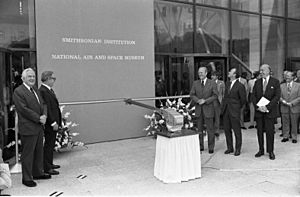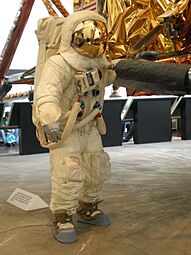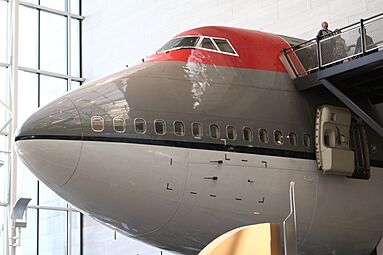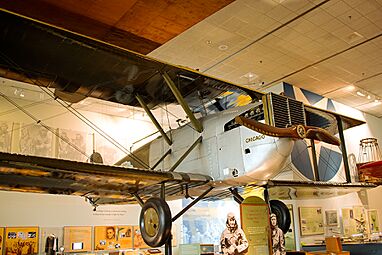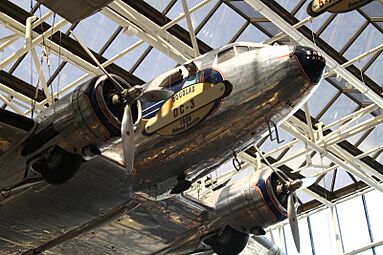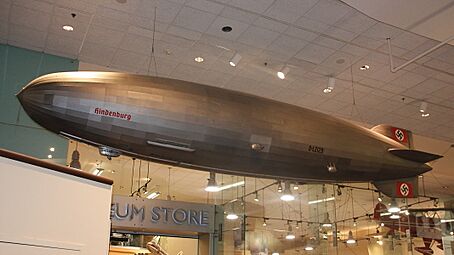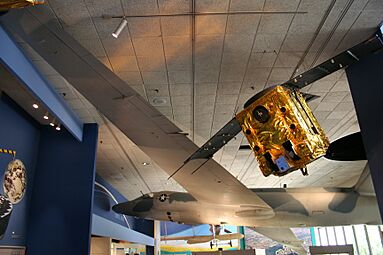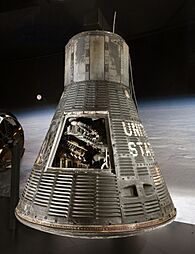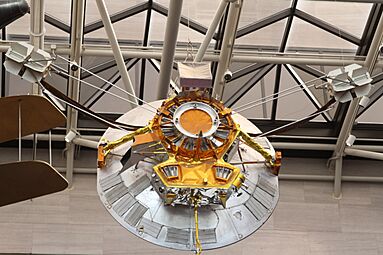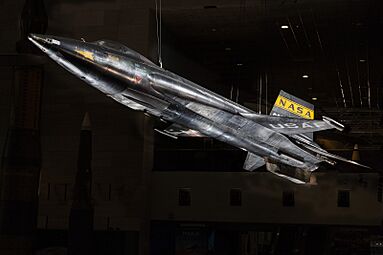National Air and Space Museum facts for kids
 |
|
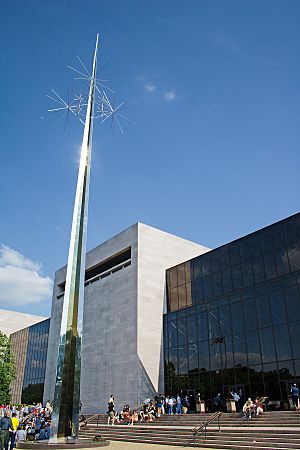
Ad Astra sculpture at the museum entrance on the National Mall
|
|
| Lua error in Module:Location_map at line 420: attempt to index field 'wikibase' (a nil value). | |
| Former name | National Air Museum |
|---|---|
| Established | 1946 (as the National Air Museum) |
| Location | Washington, D.C. |
| Type | Aviation museum |
| Accreditation | American Alliance of Museums |
| Visitors | 3.1 million visitors (2023) |
| Public transit access | |
The National Air and Space Museum (NASM) is a super cool museum in Washington, D.C., USA. It's part of the Smithsonian Institution. This museum is all about the amazing story of human flight and exploring outer space.
It started in 1946 as the National Air Museum. The main building, which you can find on the National Mall, opened its doors in 1976. In 2023, over 3 million people visited the museum! This makes it one of the most popular museums in the United States and around the world.
The museum is a big center for learning about how aviation and spaceflight have changed over time. It also teaches about planets and Earth's geology. What's really neat is that most of the airplanes and spacecraft you see are the real ones, not just copies! You can see the Apollo 11 Command Module Columbia, which went to the Moon. There's also the Friendship 7 capsule flown by John Glenn, and Charles Lindbergh's famous Spirit of St. Louis airplane. Near the entrance, you'll find the Wright brothers' first airplane, the Wright Flyer.
The museum also has a huge extra building called the Steven F. Udvar-Hazy Center. It's located near Dulles International Airport. This center has a special hangar where they fix up and store many of the museum's amazing artifacts. Other restoration work happens at the Paul E. Garber Preservation, Restoration, and Storage Facility in Suitland, Maryland.
The main museum building on the National Mall has been getting a big makeover since 2018. Some parts of the museum are closed during this time. As of August 2025, many galleries are open, but some are still being worked on. The museum expects to have all its galleries open by 2026.
Contents
Museum History
How the Museum Started
The Air and Space Museum was first called the National Air Museum. It was created on August 12, 1946, by a special law signed by President Harry S. Truman. Some of the museum's oldest items go all the way back to 1876! For example, the Smithsonian got a collection of kites from China after an exhibition. The first item the museum actively bought was a steam engine for aircraft in 1898.

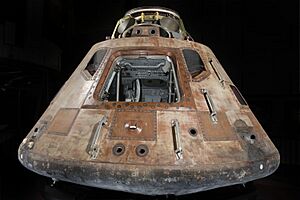
After the museum was created, there wasn't one big building to hold all the cool things they collected. Many items came from the United States Army and United States Navy, including planes from World War I. Some were shown in other buildings, and some were kept in a large temporary shed. Big rockets were even displayed outside! A lot of the collection had to stay in storage because there wasn't enough space.
After World War II, many more aircraft were given to the Smithsonian. This, plus the need for space during the Korean War, made the Smithsonian look for its own place to store and fix planes. The current Garber Facility was given to the Smithsonian in 1952.
Building the Main Museum
The museum's location on the National Mall used to be an armory, which became a hospital during the Civil War. Later, temporary buildings from World War I were there until the 1960s.
The exciting space race in the 1950s and 1960s led to the museum being renamed the National Air and Space Museum. Finally, money was approved to build the new museum. It opened on July 1, 1976, during the United States Bicentennial celebrations. Michael Collins, who flew to the Moon on Apollo 11, was the director at that time.
Recent History
In 1988, a glass area called the Wright Place was added to the museum. It first had a restaurant, but later became a food court in 2002 with popular places to eat.
The Steven F. Udvar-Hazy Center, the museum's large annex, opened on December 15, 2003. It was built with money from a private donation.
The museum also has special items like COSTAR, which was a part of the Hubble Space Telescope. It also has the backup mirror for the Hubble. In 2018, the museum received a device that sent the first tweet from space!
Museum Design
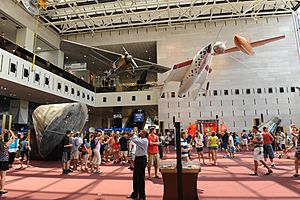
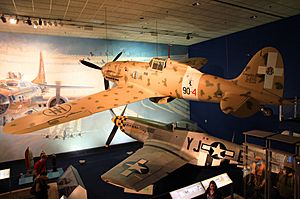
The museum is very close to the United States Capitol building. So, the designers wanted a building that looked great but didn't take away from the Capitol. Architect Gyo Obata designed the museum with four simple marble cubes. These cubes hold the smaller exhibits. They are connected by three large glass and steel areas that display bigger items like rockets, planes, and spacecraft. The museum uses the same pink Tennessee marble as the National Gallery of Art nearby. It was finished in 1976. The large glass wall on the west side of the building can even open up to bring in airplanes!
Renovations and Updates
Since it opened in 1976, the museum has had some basic repairs. In 2001, the glass walls were replaced.

In 2014, the museum announced a big renovation of its main entrance hall, "Milestones of Flight." This update was paid for by a large donation from Boeing. The hall was renamed the "Boeing Milestones of Flight Hall." The renovation involved moving some older exhibits and bringing in new ones. For example, the famous filming model of the USS Enterprise from the original Star Trek TV show was moved into this hall. The renovation also added cool touch-screen information kiosks for visitors.
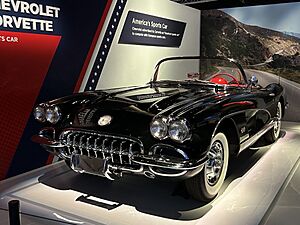
By 2015, it was clear the museum needed even more big renovations. The building's systems were old and causing problems. For example, the roof was leaking, and the marble outside was cracking. The glass walls were letting in too much ultraviolet light, which was damaging some exhibits like John Young's spacesuit. Also, the museum needed better access for people with disabilities and improved security.
The Smithsonian started planning a huge renovation project. This included replacing the entire outside of the building with new Tennessee marble. The glass walls were also replaced with special panels to protect the exhibits. The goal was to make the museum safer, more accessible, and better for visitors. The renovation project was expected to cost a lot of money, with funds coming from both the government and private donations.
The museum began closing some galleries for renovation in late 2018. It stayed open during most of this time, except for a period in early 2020 due to the COVID-19 pandemic. On March 3, 2022, the museum temporarily reopened. The renovation also included building a new learning center. The western side of the museum, with eight new galleries, the planetarium, and a cafe, reopened on October 14, 2022. The eastern side is expected to reopen in 2024.
Museum Leaders
Carl W. Mitman was the first head of the museum, from 1946 to 1952.
Here are some of the people who have led the museum:
- Philip S. Hopkins, 1958–1964
- S. Paul Johnston, 1964–1969
- Frank A. Taylor (acting), 1969–1971
- Michael Collins, 1971–1978
- Melvin B. Zisfein (acting), 1978–1979
- Noel W. Hinners, 1979–1982
- Walter J. Boyne, (acting 1982–1983) director 1983–1986
- James C. Tyler (acting), 1986–1987
- Martin O. Harwit, 1987–1995
- Donald D. Engen, 1996–1999
- John R. Dailey, 2000–2018
- Ellen Stofan, 2018–2020
- Christopher U. Browne, (acting 2020–2022) director 2022–present
Photo Gallery
The main museum has many amazing items. As of June 2007, it included 61 aircraft, 51 large space artifacts, and over 2,000 smaller items.
-
Apollo Lunar Module LM-2, used for ground testing the spacecraft.
-
Apollo 15 mission: space suit worn on the Moon by David Scott in 1971.
-
Breitling Orbiter 3, the first non-stop balloon flight around Earth (1999).
-
A Douglas DC-3 airplane.
-
A 25-foot-long model of the LZ 129 Hindenburg used in the 1975 film The Hindenburg.
-
A Lockheed U-2 spy plane and a spacecraft.
-
Missiles: a Soviet SS-20 and a U.S. Pershing II.
-
SpaceShipOne, the first private spaceship to carry a human crew (2004).
Phoebe Waterman Haas Public Observatory
The Phoebe Waterman Haas Public Observatory opened in 2009. It's a great place to look at the sky! It has a powerful 16-inch telescope and other special telescopes to see the Sun. The observatory is open to the public from Wednesdays through Sundays during the day. It also opens about once a month at night for stargazing.
Public Programs and Learning
In 2014, the museum started a TV show for middle school students called STEM in 30. This show teaches kids about science, technology, engineering, math, art, and history. It uses the museum's artifacts and features special guests from the world of air and space. The museum also has regular programs called "What's New in Aerospace" with special guests.
See also
 In Spanish: Museo Nacional del Aire y el Espacio de Estados Unidos para niños
In Spanish: Museo Nacional del Aire y el Espacio de Estados Unidos para niños


